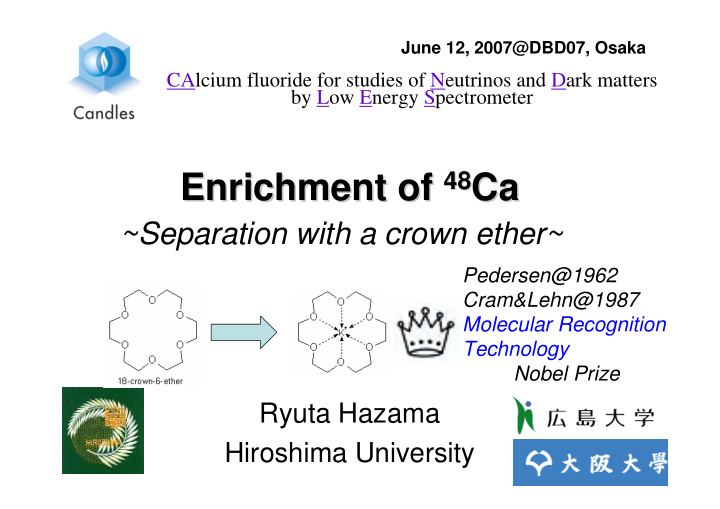



June 12, 2007@DBD07, Osaka CAlcium fluoride for studies of Neutrinos and Dark matters by Low Energy Spectrometer 48 Ca Enrichment of 48 Ca Enrichment of ~Separation with a crown ether~ Pedersen@1962 Cram&Lehn@1987 Molecular Recognition Technology Nobel Prize Ryuta Hazama Hiroshima University
48 Ca enrichment • Natural abundance → 0.187% – Enriched isotope → expensive (elemag. separator; Calutrons) ~200K$/g ~10g × 2 (in the world) → no gaseous compounds A.I.Karchevski at room temp. ββ isotopes; 48 Ca, 96 Zr, 150 Nd etc. Gas centrifuge
for Ca × × Find a cost-effective & efficient way of enrichment!!!
Unique Property of Crown Ether Complexing of cations(anions) by neutral molecules is an uncommon phenomenon. Stability is ~10 4 × no-ring(crown) Crown Ether • Held by electrostatic attraction • • • between negatively charged O- of C C - - the C-O dipoles & cation (Ca 2+ ) O O C C • How well the cation fits into the • • • - - Ca 2+ O O crown ring C • • Liquid(aq-salt)-liquid(org-crown) • • - - C O O C C extraction in isotopic equilibrium Dicyclohexano 18-crown-6 DC18C6 Total # of atoms in the ring # of oxygen atoms in the ring
Ca Isotope effects ~ ~ ~ Separation Principle ~ 40 Ca 2+ (aq)+ 48 CaL 2+ (org) CaCl 2 aqueous 48 Ca phase 48 Ca 2+ (aq)+ 40 CaL 2+ (org) 0.07M 40 Ca Crown-chloroform organic DC18C6: Aldrich Chemical, 98.0% CHCl 3 :Nakarai Tesque, 99.0% CaCl 2 :Nakarai Tesque, 95.0% Solvent Extraction process 1.vacant extraction to reduce impu. 2.mixed & stirred for 1 hour ° C 7 ° ° ° 3. standing for 1 hour @ 7 7 7 4. LLE iterated 6 times Magnetic Stirrer B.E.Jepson&R.Dewitt, J. Inorg.nucl.Chem38(1976)1175
The mean square Nuclear charge radius Can be fractionated from of Ca Ca? 0 4 the most abundant Two doubly magic isotopes; A parabolic behavior L.Vermeeren et al., J.Phys.G,22(1996)1517 40 Ca 42 Ca 43 Ca 44 Ca 46 Ca Ca 48 Ca isotope abunda 96.9 0.65 0.135 2.09 0.004 0.187 nce ( % )
Major background molecular ions formed from the Ar Plasma, nebulized water and dissolved/contained air. + m/z= + × × × × Resolving power Max resolution=12000 R=m 1 /(m 2 -m 1 ) × × × × Enemy
How to measure 40 Ca? 1. TIMS(TRITON Thermo Electron) Only four TRITONs in Japan No-Ar 2. Reaction(collision)-cell ICPMS Perkin Elmer ELAN-DRCII@Kochi Univ. Q inside reaction-cell allows use of ammonia � can avoid interference of Ar by reaction-gas Simple collision-cell must use simple gas(H 2 , He) to limit adverse side reaction products 40 Ar + 40 Ar Ar + + 40 Ca Ar + + NH 3 + NH 3 Ca + + + Ar � NH 3 Reduce Ar + � 10 9 >10 3 NH 3
Ar + =15.76 eV 10.16eV Charge transfer is allowed Ca+=6.11 eV for Ar+, but disallowed for Ca+ Ca(6.11eV)<NH3(10.16eV)<Ar(15.76eV)
40 Ca, 48 Ca are doubly magic � A parabolic behavior δ <r 2 > from mass effect Optical Isotope Shifts K.Helig&K.Steudel,Atom.Data Nucl. Data Tables 14(1974)613 Nuclear mass effect > Nuclear size&shape effect!!! This is crucial asset to realize 48 Ca enrichment (from 40 Ca)
Comparison 1.0020 1.0028 Preliminary 1.0010 1.0007 1.0010 Need to verify by 1.0010 1.0006 precise TIMS & 1.0009 More iterate LLE 1.0006~1.0013 ~800 iteration 0.187 � 2.0%
Prospect for Mass production Column chromatography LLE by Microchannel/reactor using crown ether resins • Fast & Highest • Multi-stage process conversion synthesis • Slow & low conversion • Aqueous-organic multi- phase flow Ca solution: Analyte(mobile phase) Packed column (stationary phase) = Eichrom or IBC Resin 48 ~ 1.0028 Prof. Y. Fujii@TIT Frontal development: α 40
Macro)10cm cube S/V~0.6/cm 250 µ m wide,100 µ m deep, and 3cm length S/V~80/cm No-stirring,Fast!!
100 µ m wide,40 µ m deep, and 40cm length
World’s 1 st 30 ton/yr production Microchip Chemical Plant ~2L/h 3000 3000 3000 microchannels ( 3000 ( ( (10 10 10 10 blocks ) ) ) ) 80 80μ 80 80 μ μ μ gel particles
Summary • The preliminary largest separation factor of Ca by LLE using DC18C6 is suggested .This still needs to be checked by TIMS, temp.& concentration dependence. • We evaluated each contribution ratio of the field shift/hyperfine splitting shift effect to the mass effect of Ca for the 1 st time. The contributon of the field shift effect is small, especially for 40 Ca- 48 Ca, compared with Cr. • These indications are promissing towards the mass production of enriched 48 Ca by the chemical separation method with the help of resins and/or microchannel chip. Many Thanks to Prof. Fujii, Y. Sakuma, M. Tanimizu, M. Tokeshi & Y. Shibahara
Recommend
More recommend